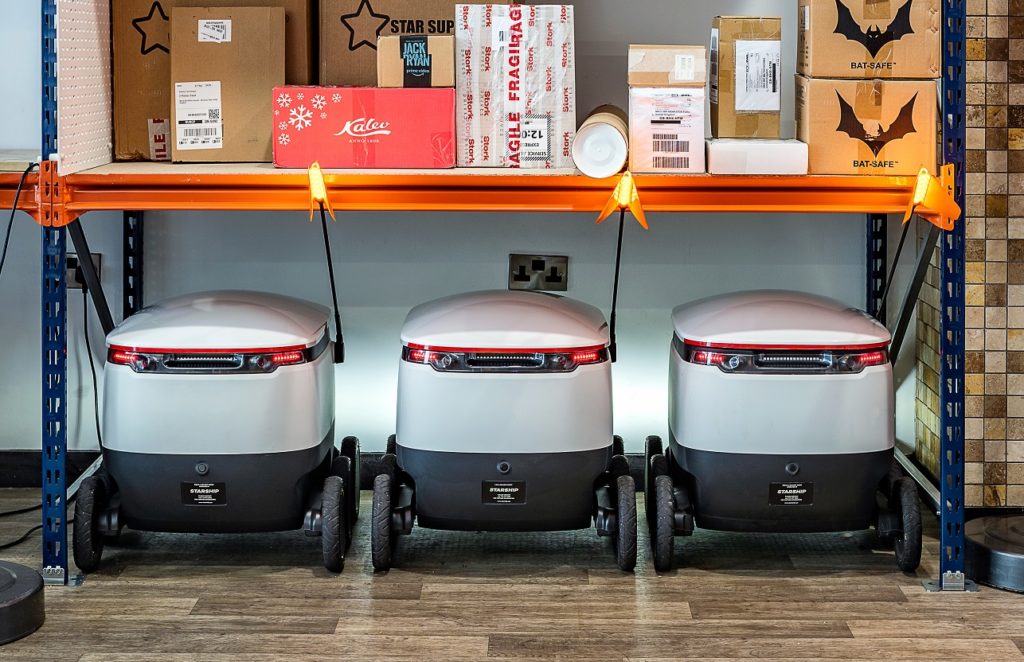Starship has launched a new delivery service powered by robots. Is it a legitimate last-mile alternative? Analysis from Marek Różycki (Last Mile Experts) and Ian Kerr (Postal Hub Podcast).
Has the time for last-mile robot delivery finally come? Estonia’s Starship Technologies thinks so. Its AGVs (autonomous ground vehicles, or robots) will start delivering parcels in the UK following several European pilots, including one at Milton Keynes.
The last mile is a key area for innovation as it accounts for some 50% of a parcel’s delivery cost, and as labor becomes scarcer we can expect to see last-mile costs rise. But can AGVs really meet customer expectations and fully replace the human on the final leg of delivery to the doorstep?
How it works
Starship is launching a subscription-based delivery model, for which customers pay a monthly fee of £7.99 (US$10). Customers use the address of a nearby Starship depot as their shipping address when ordering online. They’re notified when their packages arrive at the depot, and can then schedule delivery to their home address for a time when they’re at home.
But here comes the interesting part: packages will arrive via a Starship robot, which remains locked until the customer unlocks it via the Starship app.
Launching at scale will be no mean feat. There are no overarching regulations for autonomous delivery, with some local governments requiring human supervision of AGVs.
Consolidation of deliveries
By allowing customers to ship parcels to Starship’s depot to await final delivery to residential addresses, parcels could be consolidated for a single residential delivery attempt. This puts the customer at the center of the delivery experience.
The current robots have a modest capacity, limiting their ability to handle consolidated deliveries. Could we see larger robots in future, or will we just see more delivery robots on footpaths?
Security
Starship has implemented a variety of security measures to protect pedestrians as well as the robot’s cargo. Human operators can take control of the robot if required. But questions remain, such as: What happens if someone trips over a robot and is seriously injured? What if a car hits the robot on a pedestrian crossing? What about value-added services currently provided by humans (carry in, ID check, cash on delivery, etc.)?
A bit extreme, but what happens if terrorists get hold of a few lookalike devices and release several robot-driven bombs?
Then there’s robot ‘bullying’, where members of the public have interfered with robots in the course of deliveries, and even abducted them. Robots might be secure enough to discourage opportunist thefts, but what happens when they start delivering high-value items or pharmaceuticals?
Robots can’t ring doorbells
Other than the incremental subscription, perhaps the biggest drawback relates to the fact that the customer still has to ‘meet the robot at the doorstep’, but unlike the traditional model, if you live in an apartment building, you have to come to the robot.
Some deliveries might be done by robots that are carried part of the way by a van. Although the robot is automated, the van still needs a human driver… for now.
Finally, the robot’s limited capacity means the service cannot be a complete solution, even for what can be considered ‘standard’ sized courier parcels.
Let’s see how Starship does with this initiative. Given the additional cost for the consignee and restrictions on usage, our money is still on less advanced robots in the form of parcel lockers. It would take a more sophisticated type of robot, able to climb steps and carry out other human functions, to really disrupt in this space.
Bios:

Ian Kerr is the founder and host of the Postal Hub Podcast, the weekly podcast for the postal and delivery sectors.

Marek Różycki is managing partner at Last Mile Experts, specializing in CEP and e-commerce last-mile advisory.
![]()


